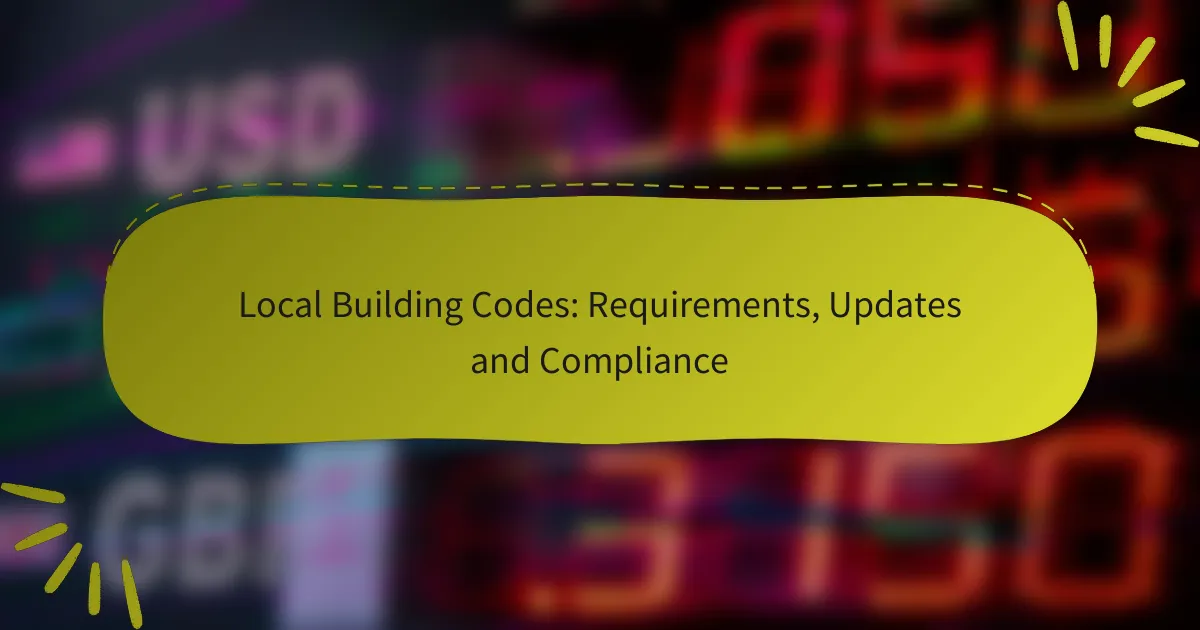Estonia’s local building codes are essential regulations designed to guarantee safety, functionality, and sustainability in construction projects. These codes address critical aspects such as structural integrity, fire safety, accessibility, and energy efficiency, guiding builders and architects in ensuring compliance. Staying updated on these regulations and recent enhancements is vital for successful project execution and adherence to modern standards.

What are the local building code requirements in Estonia?
In Estonia, local building code requirements encompass various regulations that ensure safety, functionality, and sustainability in construction. These codes cover structural integrity, fire safety, accessibility, and energy efficiency, guiding builders and architects in compliant project execution.
Structural integrity standards
Structural integrity standards in Estonia mandate that buildings must withstand various loads, including dead loads, live loads, and environmental factors such as wind and snow. Compliance with the Eurocode standards is essential, as they provide guidelines for design and construction practices.
Builders should conduct regular inspections and use quality materials to ensure that structures remain safe over time. Engaging a certified structural engineer during the design phase can help identify potential issues early in the process.
Fire safety regulations
Fire safety regulations in Estonia require that buildings incorporate measures to prevent and control fires, including proper material selection and installation of fire detection systems. Buildings must have clearly marked escape routes and accessible fire exits to ensure occupant safety.
Regular fire safety audits are recommended to identify vulnerabilities. Additionally, compliance with the Estonian Fire Safety Act is crucial for obtaining necessary permits and ensuring that all safety measures are up to date.
Accessibility guidelines
Accessibility guidelines in Estonia aim to ensure that buildings are usable by all individuals, including those with disabilities. This includes features such as ramps, wide doorways, and accessible restrooms, which must be integrated into new constructions and significant renovations.
Designers should refer to the Estonian Accessibility Standards to ensure compliance. Engaging with accessibility consultants can provide valuable insights into best practices and help avoid common pitfalls in design.
Energy efficiency mandates
Energy efficiency mandates in Estonia focus on reducing energy consumption in buildings, promoting sustainability and lower utility costs. New constructions must meet specific energy performance standards, often requiring the use of energy-efficient materials and systems.
Builders should consider incorporating renewable energy sources, such as solar panels, to enhance compliance with these mandates. Regular energy audits can help existing buildings identify areas for improvement and ensure ongoing compliance with energy regulations.

How to ensure compliance with local building codes?
Ensuring compliance with local building codes involves understanding the specific regulations in your area and taking proactive steps to meet them. This includes obtaining the necessary permits, conducting regular inspections, and engaging certified professionals throughout the construction process.
Obtain necessary permits
Before starting any construction project, it is crucial to obtain the required permits from local authorities. These permits ensure that your project meets safety, zoning, and environmental regulations.
Check with your local building department to determine which permits are needed for your specific project. Common permits include building, electrical, plumbing, and mechanical permits. Failing to secure these permits can lead to fines and project delays.
Conduct regular inspections
Regular inspections are vital to ensure ongoing compliance with building codes during construction. Schedule inspections at key stages of the project, such as foundation, framing, and final walkthroughs.
Local building inspectors will verify that the work meets code requirements and identify any issues that need to be addressed. Keep in mind that inspections may require advance notice, so plan accordingly to avoid delays.
Engage certified professionals
Hiring certified professionals, such as architects, engineers, and contractors, can significantly enhance compliance with local building codes. These experts are familiar with the regulations and can help design and execute projects that meet all necessary standards.
Ensure that the professionals you hire have the appropriate licenses and certifications for your area. This not only helps with compliance but also adds credibility to your project, potentially reducing the risk of costly mistakes or rework.

What are the recent updates to Estonian building codes?
Recent updates to Estonian building codes focus on enhancing energy efficiency, improving fire safety, and ensuring better accessibility in buildings. These changes reflect a commitment to modernize construction practices and meet evolving societal needs.
Changes in energy efficiency standards
Estonian building codes now emphasize stricter energy efficiency standards aimed at reducing overall energy consumption in new constructions. Buildings are required to meet specific thermal performance criteria, which may include improved insulation and energy-efficient windows.
For instance, new residential buildings must achieve a certain energy performance rating, often measured in kilowatt-hours per square meter per year (kWh/m²/a). This encourages the use of renewable energy sources, such as solar panels, to meet energy needs sustainably.
New fire safety protocols
Fire safety protocols have been updated to enhance the protection of occupants and property. These protocols now require more comprehensive fire risk assessments during the design phase, ensuring that buildings incorporate adequate fire-resistant materials and systems.
Additionally, the codes mandate clearer evacuation routes and improved fire alarm systems. Regular fire safety drills and training for building occupants are also encouraged to ensure preparedness in case of emergencies.
Updates on accessibility requirements
Accessibility requirements have been strengthened to ensure that all buildings accommodate individuals with disabilities. New constructions must include features such as ramps, wider doorways, and accessible restrooms, aligning with the principles of universal design.
These updates aim to create inclusive environments, making it easier for people with mobility challenges to navigate public and private spaces. Compliance with these requirements is essential for obtaining building permits and ensuring community integration.

What are the penalties for non-compliance with building codes?
Penalties for non-compliance with building codes can include fines, legal repercussions, and mandatory remediation actions. These consequences aim to ensure that construction projects adhere to safety and quality standards.
Fines and legal repercussions
Fines for violating building codes in Estonia can range from hundreds to thousands of euros, depending on the severity of the violation. Legal repercussions may include court proceedings, which can lead to additional costs and delays in project completion.
Repeated violations can escalate penalties, potentially resulting in the suspension of construction permits. It’s crucial for builders and property owners to stay informed about local regulations to avoid these financial and legal pitfalls.
Mandatory remediation actions
If a building is found to be non-compliant, authorities may require immediate remediation actions. This can involve making structural changes, obtaining necessary permits, or even demolishing non-compliant sections of the building.
Failure to comply with remediation orders can lead to further fines and legal action. Property owners should prioritize addressing any identified issues promptly to mitigate risks and ensure compliance with building codes.

How to choose a contractor for building code compliance?
Choosing a contractor for building code compliance involves assessing their qualifications, experience, and reliability. A well-selected contractor ensures that your project meets local building regulations and standards, minimizing potential legal issues.
Verify credentials and licenses
Start by confirming that the contractor holds the necessary licenses and certifications required by Estonian law. This includes checking for a valid construction license and any specific certifications related to the type of work being performed.
Additionally, ensure that the contractor is registered with relevant professional bodies, such as the Estonian Chamber of Commerce and Industry. This registration can provide further assurance of their credibility and adherence to industry standards.
Check previous project references
Request references from past clients to gauge the contractor’s performance on similar projects. Look for feedback on their ability to meet deadlines, stay within budget, and comply with building codes.
Consider visiting completed projects or asking for case studies that demonstrate their experience with code compliance. This firsthand insight can help you evaluate their capability to handle your specific requirements effectively.

What resources are available for understanding building codes in Estonia?
In Estonia, various resources exist to help individuals understand local building codes, including government websites, publications, and local associations. These resources provide essential information on compliance, updates, and best practices for construction projects.
Government websites and publications
The Estonian government offers several official websites that contain comprehensive information about building codes and regulations. Key resources include the Ministry of Economic Affairs and Communications and the Estonian National Building Register, which provide guidelines, legal texts, and updates on building standards.
Publications such as the “Building Code of Estonia” and various technical guidelines are also available online. These documents outline the requirements for construction, renovation, and safety standards, ensuring that builders and homeowners have access to the necessary information.
Local building associations
Local building associations in Estonia play a crucial role in disseminating information about building codes. These organizations often provide training sessions, workshops, and seminars to help builders and contractors stay informed about the latest regulations and compliance requirements.
Joining a local building association can also offer networking opportunities and access to resources such as expert advice and best practices. Engaging with these associations helps ensure that construction projects adhere to local codes and standards, reducing the risk of non-compliance.
